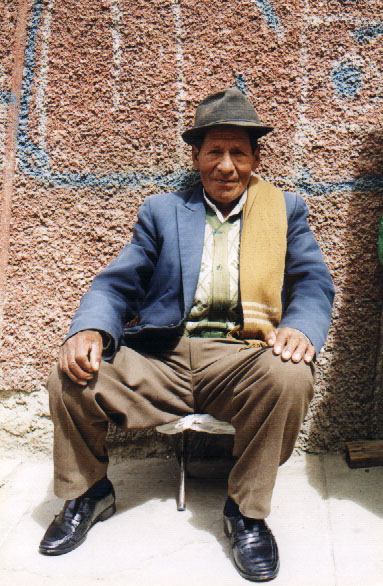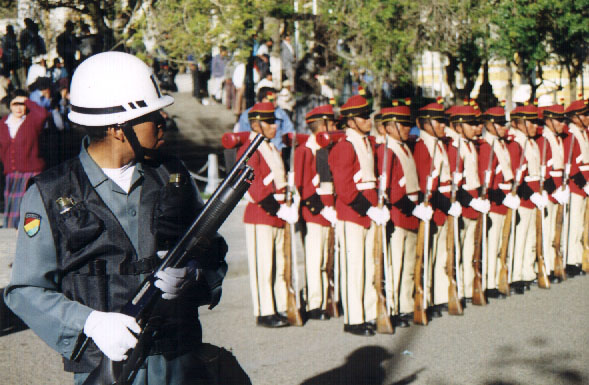

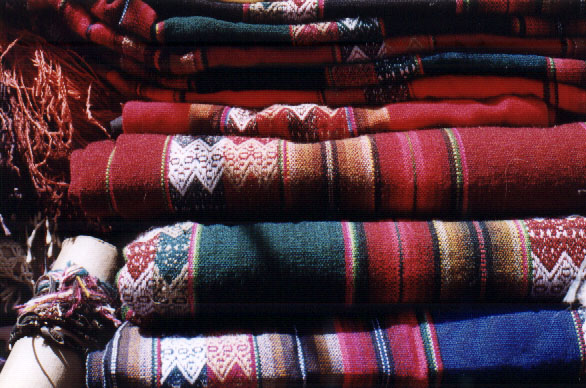 |
| Blankets for sale along Calle Linares, La Paz |
I awoke just after 7am with a bit of a headache. Both Susanne and I had been plagued by a nasty head cold since our departure from Machu Picchu; since Copacabana I had wondered whether it had grown into a full blown sinus infection. As far as I could tell the worst was past for me; I was no longer waking up in the middle of the night to blow my nose every other hour. Susanne's cold, on the other hand, seemed to be running a few days behind mine. Hopefully she wouldn't have too many problems, especially now that we were in the warmer and cozier surroundings of La Paz.
Susanne and I got breakfast at the Hostal Republica's small restaurant. They had a desayuno Americano for 15 bolivianos that included both ham and sausage - a little more arterial poison than I could handle. Instead I chose the desayuno Continentale, a 10 boliviano plate of stale toast, butter cookies, coffee and pineapple juice. The small cookies went well with the rich coffee but the toast was by far the worst I've ever had - I could see they had two dozen pieces of toast in the oven at once, desiccating slowly at a low heat. "Tomorrow let's eat somewhere else," I said to Susanne, thumping the petrified toast on the table.
We didn't have much of an agenda for the day apart from walking around and getting to know the city. I suggested we start off the morning with a stroll to Plaza San Francisco, the home of the exquisite Iglesia de San Francisco. After leaving the hotel and walking a half a block down Illimani we turned left to walk downhill along Calle Loayza before heading right along Avenida Potosi. Calle Loayza makes a steep drop towards the Prado, La Paz's main commercial thoroughfare, three blocks away. There's a 50-foot drop between Illimani and Potosi that forced city planners to incorporate a set of stone steps down the sidewalk, just to stop people from sliding down the embankment. I could see why so many people have compared the streets of La Paz to San Francisco, California - San Francisco at an altitude of the Rocky Mountains, perhaps.
 |
| Iglesia de San Francisco, La Paz |
As we turned right on Potosi the avenida flattened out into what appeared to be a banking district. Small casa de cambios occupied the space between large banks with armed guards standing out front. We followed Potosi for five or six blocks until it terminated at a busy intersection of the Avenida Mariscal Santa Cruz - one of the many individually named sections of the Prado. After dashing across the avenida and dodging the morning rush hour traffic we found ourselves at the edge of Plaza San Francisco, the home of the oldest major church in La Paz, the Iglesia de San Francisco. The church was founded in 1548 by Fray Francisco de los Angeles and was built soon after. Sixty years later a snowstorm collapsed the original structure; over a century past before the iglesia was rebuilt in the mid-1700s.
Both the church and the plaza were constructed out of brownish gray stone blocks: earthy clay hues that would have rendered the entire image as a sepia-toned daguerreotype if it weren't for the dozens of brightly dressed campesinas occupying the plaza benches. Several hundred people in all roamed about the plaza, reading newspapers, gossiping, getting shoeshines, selling trinkets. As Susanne and I entered the plaza an older gentleman approached us and held out his hand just below my face. "Trilobite señor?" he started to ask as I politely waved him away. "Did he say trilobite?" I asked Susanne. "I think so," she replied. "It looked like a fossil." The sedimentary rocks of Bolivia are well known to brim with bounteous paleontological treasures, but it struck me as odd that the local touts would hawk fossils as readily as local street children offering shoeshines.
 |
| Plaza San Francisco, La Paz |
Susanne and I walked around the plaza, people-watching and taking pictures as unobtrusively as possible. A trio of soldiers stood outside the church entrance; I tried to get a photograph of them with my telephoto but one of them spotted me and gave me the evil eye. We worked our way to the church itself, curious to see if it was open for visitors. Indeed, I spotted several families going through its massive wooden doors, so we put away our cameras into our daypacks and entered the church. The interior was decorated in the typical Andean colonial style, not unlike the cathedral in Cusco. One difference I did note, though, was the plentiful light that beamed through high stained glass windows. While Cusco's cathedral was dark and somber, Iglesia del San Francisco glowed from the rays piercing through the portals. Twenty or so parishioners sat along its aisles and prayed; several campesinas kneeled. Susanne and I paced the perimeter of the interior, making our best effort not to interfere with the congregants. Along the church walls stood large altars, each manned by a resident saint that appeared to have been sculpted in wax. Perhaps they were plastic or frescoed plaster - I couldn't tell without more light. Near the far end of the church I noticed one statue, San Francisco de Los Angeles himself, who possessed a neon halo radiating a bright day-glo blue. "Neon inside a church?" I whispered to Susanne. "I haven't seen religious neon since that streetside mission in southside Chicago." Actually, the more I stared at the luminescent saint the more I liked it. Perhaps they're on to something here.
Returning to the bright, busy scene along Plaza San Francisco, Susanne and I walked towards the street along the left side of the church. We were at the bottom of Calle Sagárnaga, the steep cobblestone road known as Artesenia Alley because of its abundant folk crafts shops. Sagárnaga was the lifeblood of the La Paz shopping scene, at least as far as visitors are concerned: sweaters, leather goods, wall hangings, silver, pottery, even musical instruments could all be found within a few steps of each other. I imagined we'd spend a good part of the next few days here, shopping for all those knick-knacks and curios we'd managed to neglect buying in Peru or Copacabana. Even if we didn't actually purchase much along Sagárnaga, I quickly felt as if I could spend hours wandering the shops and stalls, watching campesinas haggle with itinerant visitors throughout the day.
While there were ample opportunities to keep busy here in this artist colony, our next stop would be a market with a much darker side. Somewhere not far from here we would find this place which goes by many names, including El Mercado de Hechiceria (the Market of Witchcraft) and El Mercado de los Brujos (the Market of Wizards). To local Aymara campesinos, though, it is simply known as Laki'asina Catu: the Witches' Market. For years the Aymara have come to the Witches' Market to purchase potions, powders, talismans and other magical items that carry weight in the spiritual world. Whether you were looking to improve your fertility or to place a curse on your mother-in-law, you'd probably be able to find the right mystical implement at the Witches' Market. Everything I've ever read about the market has always highlighted one particular item - preserved llama fetuses. Llama sacrifice has been an important element in Aymara ritual for centuries, especially when it comes to consecrating a new home; even today you'll find many businesses sacrificing a llama to commemorate a new office building. Yet the average Aymara family cannot afford to buy a full-grown llama, so over time the campesinos adopted the practice of offering llama fetuses as a sacrificial substitute. Dead animals, potions, curses: the Witches' Market sounded like a throwback to a medieval Andean epic. I was eager to find out whether its reputation was a well-earned spookfest or an exaggeration of basic traditions played up for the turistas.
Susanne and I walked the short distance up Sagárnaga before taking a right on the next street. I was under the impression that the Witches' Market would be somewhere near the end of this block, yet all we found here were several wood shops, each with stacks of freshly varnished desks and chairs piled along the curbside. I pulled out my Lonely Planet and flipped through its pages to find the map of central La Paz. After staring at the map for a moment I realized we were still one block below the market. "We should have continued up Sagárnaga for another block before making that right," I said to Susanne. "I assume if we take a left on the next street and head uphill for one more block we should be able to find it."
We passed two or three more wood shops before reaching Calle Santa Cruz (not to be confused with Avenida Mariscal Santa Cruz - a subsection of the Prado). Santa Cruz was an archetypal La Paz street, a crowded thoroughfare of shops and market stalls sloping high up a steep hill. Susanne and I both took our time mounting the hill; even though we've probably adapted to the altitude by now, we saw no reason to kill ourselves this early in the day. Both sides of the calle were lined with sporting goods shops - trophies, soccer cleats, game balls and uniforms. I had mentioned to Susanne several weeks earlier I wanted to get a Bolivian soccer shirt in La Paz. It looked like we'd found the place to buy it. "Let's come back here later and find that shirt," I said.
We soon reached the corner of Santa Cruz and Linares, the intersection that marked the eastern boundary of the Witches' Market. Calle Linares was a long, rolling hill covered in rounded cobblestone - the kind of pedestrian-unfriendly cobblestone I've tripped over on so many occasions, from the winding passageways along Edinburgh's Royal Mile to the alleyways of Barcelona's Barri Gotic. Further up the road I could hear music playing from a charango shop. Nothing seemed really out of the ordinary until I saw several market stalls lined along the left side of the street. Young campesinas stood guard over an alchemist's paradise of magical goods - statues of the goddess Pachamama; plates of powdered sulfur, iron ore and assorted mineral dusts; tiny glass bottles of mysterious tinctures, solutions, and other elixirs of toil and trouble. There was no mistaking it - we had found el Mercado de Hechiceria. The Witches' Market was much smaller than I expected: hardly a market at all in the typical crowded-with-shoppers sense, in fact. There were no more than three or four women selling things here, and at that particular moment we were the only customers in sight. Then again, it's not every day that the average campesino has to build a house or alleviate a curse. The Witches' Market was an open-air specialty shop. You came here when you needed to.
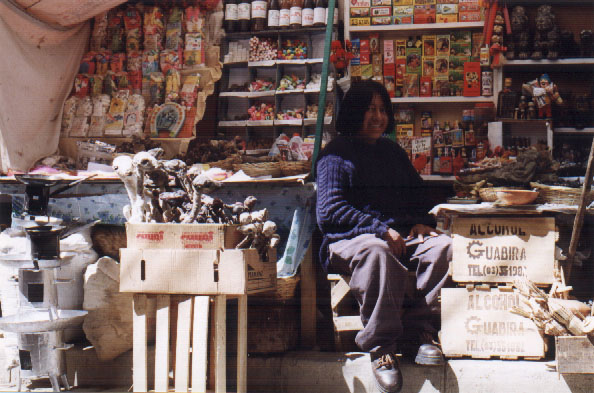 |
| Witches' Market, La Paz |
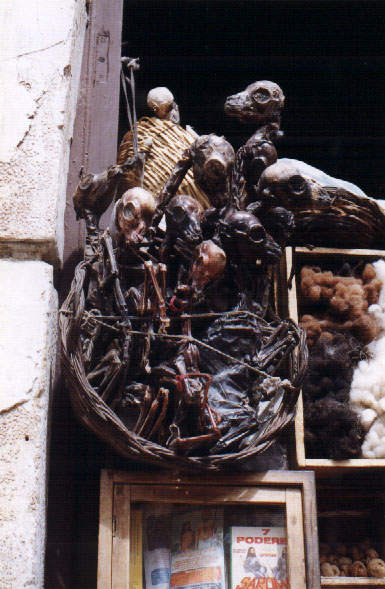 |
| Llama fetuses for sale at the La Paz Witches' Market |
We, of course, didn't exactly need to be here, but the idea of an honest-to-goodness witches' market was too intriguing to pass up. The campesinas didn't seem to mind our browsing, as long as we didn't jump in their faces, snap pictures and run off like other tourists have been known to do. The colorful concoctions and the staring faces of the Pachamama statues were the first things that caught my attention. I then looked down to a large cardboard box just below the table and noticed what appeared to be shriveled My Little Pony dolls with matted hair, big cartoon eyes and absurdly long legs. It took me a moment to realize that I had been staring at dead llamas fetuses. I really had no conception of what they might look like; for some reason the haphazard arrangement of these strange, freeze-dried creatures in a discarded appliance box caught me off guard.
"I take it you've noticed the llamas," I said to Susanne, staring at the fetuses.
"Of course," she replied. "First thing I saw."
I walked closer to one of the market stalls and perused the selection of Pachamama statues. Several dozen of them occupied a wooden shelf, most no taller than six or eight inches. "Pachamama, sí," the campesina said to me, pointing to the array of stone figures. Many of the statues showed Pachamama as a campesina with a young child and several small animals clinging to her back. "ƒsta es Pachamama y su hija Mama Coca." Pachamama was the mother earth goddess to both the Aymara and Quechua, while her daughter, Mama Coca, represented the power and the bounty of the sacred coca leaf. "Pachamama," the campesina continued, pointing to the images on the statue. "Mama Coca, y animales: la rana, la serpiente, la tortuga..." The frog, snake and turtle were all talismans of good luck, as were the images of Pachamama and her child: to possess the statue was to possess the protection of the goddesses and their familiars.
While I wasn't exactly in the market for spiritual protection, I liked the idea of bringing home a Pachamama statue for myself, perhaps for my mom as well (she collects pre-Columbian figurines). I found one particular statue carved out of a white soapstone whose thin goddess faces reminded me of a Modigliani painting. I asked the campesina how much she wanted for it. "Veinte bolivianos," she replied - just under four dollars. Before I proceeded with the haggling process I asked her to hand me the statue. I placed it on a flat surface to see how well it would stand. To my disappointment it immediately leaned to the side and teetered. I gave the statue a slight tap, causing it to tumble over into my hand. My little Pachamama was cursed by an ominously high center of gravity. After trying to stand the statue once again I returned it to the campesina. "No, gracias," I said to her, hoping she would sympathize with my plight. "Malo, malo," she replied, shaking her head as she returned the statue to its place on the shelf. "Malo means bad, right?" I asked Susanne. I didn't intend to be a bad customer - perhaps I'd have better luck later. There was plenty of time to find the right Pachamama.
We continued along the sloping cobblestone of Calle Linares, eyeing the Witches' Market stalls and music shops. Each music shop had its selection of zampoñas, flutes and other wind instruments, as well as guitars and charangos. I seriously considered buying a charango - the 10-string, ukulele sized instrument would be small enough to bring home - but the better handmade charangos easily surpassed 500 bolivianos. Unless I was serious enough to learn how to play Andean music I wasn't sure if I wanted to make the investment. I was also in the market for another sweater, though from what I had seen along Sagárnaga, the sweaters here were pricier and more limited in variety compared to the ones I had seen in Cusco. In hindsight this was a little frustrating, but hopefully I'd still be able to spot a bargain somewhere in town.
The Witches' Market petered out at the corner of Sagárnaga. On the other side of the intersection I could see a variety of colorful streamers strung from one side of the street to the other, high above the cobblestone. The streamers instantly reminded me of Kathmandu, which had been decorated generously with streamers for the Newari new year during our 1996 visit. Most of the streamers were in Spanish but one proclamation caught my eye: Internet Café. I pointed at the streamer and smiled. "Shall we check in with home?" I asked. Susanne agreed, so we stopped briefly at the café - an office on the second floor of a courtyard hostal - in order to send emails to our families and catch up on the latest news.
After using up most of our 30-minute Internet allowance Susanne and I returned to Sagárnaga hoping to find a good place for lunch. Back in Copacabana our friend Scott had recommended a place called Lobo, known for its cheap eats and backpacker crowd. I noticed that Lobo was a block or so east of Sagárnaga on Calle Illampu, another block further up the hill. We proceeded to walk high up Sagárnaga, passing a variety of tour agencies and hostals. Upper Sagárnaga appeared to become more of a typical business district, with appliance stores and wholesale fabric shops lining the left side of the road. It didn't seem like we were going to find much of interest in this part of town, so we hung a right on Illampu and walked until we found Restaurant Lobo.
Just as Scott had described it, Lobo was a backpacker joint: menus were available in both English and Hebrew. In fact, just as we were preparing to place our order, the two Israeli women we had met on the bus ride from Copacabana walked through the door.
"Long time no see," I said to them.
"Is this your first time at Lobo," asked the brunette woman, who appeared to have recovered well from her seasickness. "This is our third visit."
As they wandered off to find the Hebrew menu Susanne and I both ordered veggie lentil burgers. A few minutes later the waitress returned with two plates, each covered in huge round slabs of processed lentils on top of open buns slathered in butter. "Now that's one hell of a veggie burger," I said.
"I just wish they hadn't coated it with butter," Susanne replied, scraping it off with a knife. Considering we were eating in beef country I was surprised they even had lentil burgers in the first place, let alone delicious ones. I soon slumped over, having gorged myself to full satisfaction.
After paying the check we went over to the Israelis to say goodbye to them. Before leaving I asked them what else they've done in La Paz. "Have you been to the prison?" the brunette replied.
"Is there much to see there?" Susanne responded, surprised as I was with the question.
"Oh, it is sad," she replied. "The conditions there are not very good. You really should go."
"Okay," Susanne answered. "We'll think about it."
"The prison?" I said to Susanne as we descended the stairs to the street below.
"I have no idea either," Susanne replied. "Perhaps they knew someone who was arrested and spent some time there." I couldn't figure it out but it sounded like it might be interesting in a Midnight Express sort of way if there were time available for it. For now, though, my only major concern was some serious shopping time along the Witches' Market.
After leaving the restaurant we backtracked to Sagárnaga and walked down the hill towards Calle Linares and the Witches' Market. Immediately to our left we found a string of witches' shops that had opened since our initial visit earlier that morning. One older woman with a small shawl wrapped around her head was selling more Pachamama statues. I looked at several of the statues and found two that I particularly liked, which of course made it harder to decide which one to buy. "Cuanto cuesta?" I asked her. "Quince bolivianos," she replied - about three dollars. As I examined the Pachamamas I realized the two statues were almost mirror opposites of each other - one with Mama Coca hanging on to Pachamama's left shoulder, the other with Mama Coca on her right shoulder. "I bet these would make good bookends," I said to Susanne.
I held the two statues up to the woman and asked for a llapa, a discount for buying more than one. "Veinte bolivianos," I offered. The woman shook her head and repeated, "No llapa, no llapa - treinte bolivianos." Thirty bolivianos was no bargain, so again I insisted on 20 bolivianos. Eventually the woman relented and began to drop the price, but she froze at 25 bolivianos - just under five dollars for the two statues. That was good enough for me, so I agreed to the price. She then proceeded to tie a rainbow colored braid of alpaca yarn around each statue's neck and wrapped them neatly in several layers of newspaper. Susanne asked if she could take a picture of her. Normally the women of the witches' market frown upon photographers but they're sometimes persuaded when the request follows a successful business transaction. The woman nodded her head in approval and straightened her shoulders for the photograph.
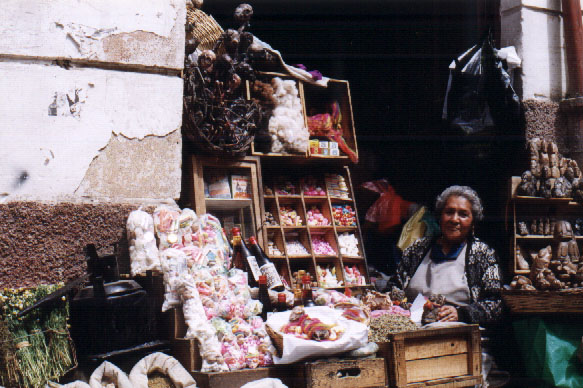 |
| Witches' Market, La Paz |
A few steps up the curb sat an older gentleman neatly dressed in a suit jacket and hat, sunning himself on a stool. He was an image straight out of an old European photo album. "Buenos tardes, señor," I said to him as I approached, pointing to my camera. He looked at the camera and smiled, replying "Sí, señor." Assuming he wanted a couple bolivianos for his time I asked him how much he would charge. "No bolivianos," he replied. "Coca, coca..."
A barter of coca leaves for a picture? That would be fine with me but I didn't have any coca, nor did I know where I could get any (though I probably could have approached any campesina in the local shops and asked her for some).
"Permiso," I replied, "no tengo coca, señor. Dos bolivianos okay?"
"Okay, okay," he muttered as he suddenly got up and walked away. Where was he going? The man crossed the street and grabbed a small sack, pulling out a colorful red cap and a poncho. Apparently he though I wanted him to pose in Aymara costume.
"Oh no, señor," I said, hoping not to lose face in any way. I pointed at his jacket and hat and smiled. "Bueno, señor."
"Okay, okay," he again replied, settling back down on his stool as I squatted on the pavement to take the photograph.
We spent the next hour or so shopping in the many artesenia co-ops along Sagárnaga. I had read somewhere that the more expensive shops tended to be further down the street, towards the Plaza San Francisco and the Prado, while the cheaper stores were usually higher up the hill. I guess it's all a matter of shoppers' endurance - if you're wealthy and lazy you won't want to bother with climbing all the way up the road. The inverse would be those of us who were willing to cough up a lung conquering the steep hillside in search of a good bargain - if you climb it, you'll get a discount for your effort. Calle Linares appeared to be the treeline between retail and wholesale prices: all the shops we visited below Linares had inflated prices for most of their goods, especially sweaters. I was actually quite disappointed with the sweater selection. Most shops sold the same collection of a dozen or so varieties for prices starting at $30 to $40, much more expensive than the shops in Cusco. Other stores sold unique sweater patterns at a cost of $70 or more. I really enjoyed poking my head from one store to another but found it hard to get serious about buying anything today. Perhaps tomorrow or Friday would be better.
As we descended Sagárnaga towards the plaza Susanne pointed at a man across the street. "Isn't that Scott from Copacabana?" she asked. Indeed it was Scott, the long-haired blonde guitarist we met at the Hostal Cúpula. We called out his name and got his attention, clearly surprising him in the process.
"Hey there," he waved. "Welcome to La Paz!" Scott had spent the day shopping and clearly had been more successful than we, holding several small bags in a fishnet sack slung over his shoulder.
"I'm doing all my Christmas shopping here," he continued. "Where else can you shop for 30 people and not bust your bank account?" Scott pulled out a small watercolor he purchased from an art gallery across the street. It was a pretty black and white La Paz street scene. "I got this from an artist in the shop over there," he said. "I might have to go back and get some more."
Scott then asked if we had any dinner plans tonight. "This is my last night in La Paz so I want to go out in style," he said. "There's a great Italian place called Restaurante Pronto in the Sopacachi neighborhood. It's really classy but they don't care if people show up dressed like us." Like us?, I thought? I knew I hadn't shaved in a few days, but... He wrote down the name of the restaurant and "Sopacachi" on a small piece of paper. "It's kinda hard to find," he continued, "so why don't we meet at Café Montmartre around 7:30? It's right around the corner from the restaurant and every taxi driver will know where it is." Susanne and I both thought it sounded like fun so we agreed to meet him at the café.
After parting company with Scott we visited the art gallery he had just recommended. The resident artist specialized in watercolors and oils, with styles ranging from abstract to neo-primitive. Susanne and I found a few nice paintings of rural villages and Aymara campesinas, including one marvelous blue watercolor of a campesina standing on a hillside as a storm came in. Susanne strongly considered buying it but decided to hold off and see if she still had the urge later in the week. We then stopped at a small café inside the mall and split a piece of angel cake over a couple of Cokes (including my first glass bottle Diet Coke - I think old fashioned glass bottles were gone by the time Diet Coke came out in the States). As we sat in the courtyard enjoying our snack we noticed a quartet of mannequins propped up near the exit, each dressed in garish polyester. Their accoutrements were bad enough, but the mannequins' most haunting features were their faces - 1950s Howdy-Doody teethy grins straight out of an abandoned Montgomery Ward. Papa mannequin looked like a bald Jim Carrey in the middle of a knee-slapping pratfall. Mama mannequin bore the false eyelashes, greasy rouge and maraschino lipstick of an old French whore. Brother and Sister mannequins were characters in a late-night pay-cable B-movie horror flick - "The mannequins are alive, and they're out for blood!!!" "Why on earth would anyone be inspired to buy that clothing after looking at those awful things?" Susanne pondered.
After paying the tab Susanne and I continued our walk past the Iglesia del San Francisco and Plaza Murillo until we reached our hotel. The Pachamama statues I had been lugging around were beginning to put a strain on my back so I was eager to drop them off in the room. When I approached the front desk for our key the resident travel agent informed me that tomorrow's trip to Tiwanaku would probably be canceled due to a blockade along the main highway. Apparently a group of cocaleros - campesino coca farmers - were blocking the road to protest President Banzer's coca eradication policy. "The protest may end tonight," she said, "so check with me tomorrow morning and we'll see if you can go. Otherwise you can visit Tiwanaku the next day."
Susanne returned to the room while I discussed our options with the tour agent. Meanwhile, the hotel receptionist, a cherubic, freckly redheaded woman named Katrina, asked me out of the blue, "Do you know anything about the Internet?" I was rather surprised by the question - rarely has anyone ever brought up my profession without my prompting on our trips outside of the US.
"Sure," I said, "I do a lot of work with schools and communities on the Net. Why do you ask?"
"I just finished taking a course on Windows 98 and Microsoft Office and was wondering how difficult it is to learn how to go online," Katrina replied. Windows 98? Microsoft Office?, I thought to myself; where did she learn her English? Reading Bill Gates biographies?
"It's really easy," I said. "Internet software has gotten smart enough for anyone to learn how to do it."
"I really want to learn about the Internet," she continued, "but it's so expensive in Bolivia. Not even most big businesses can afford it. Only a couple of companies offer Internet access so it's almost cheaper to get an account in Peru and make an international call rather than pay for it here."
"Well, that's the way it often starts for countries new to the Internet," I said. "A few companies will use the Net, their employees with introduce it to their friends and families, so the demand will spread. The government may begin to use it, increasing the number of people who want it. Eventually prices will come down but it may take a few years."
"Prices won't come down here, thanks to our president," Katrina grimaced. "Banzer is an old man who probably won't run again, so he just doesn't care about helping the rest of us. Our last president, he was really connected to the people, but he lost to Banzer. Sanchez was educated at Harvard and spoke Spanish like a Norte Americano. Banzer's campaign ads would say 'How can you trust a president who speaks Spanish like a Gringo?' Now Banzer is president and we're stuck with him."
"I have to ask," I interrupted. "Where did you learn your English?"
"In Texas," she smiled. "I spent seven years in Houston when I was a kid. But then I moved back to La Paz and didn't speak English for nine years until I got this job about a year ago. At first I didn't speak it well but the more I get to practice the better it gets."
We continued to chat for a while until I realized that Susanne must be wondering what had happened to me. I wrapped up my conversation with Katrina and returned to the room, where I found Susanne sitting on the bed looking over her journal.
"What happened to you?" she asked.
"Internet and politics talk," I replied. "And no, I didn't start it." I looked at our travel alarm clock and saw that it was just after 4pm: that gave us some time to relax, maybe go for a walk, then head to Sopacachi for dinner with Scott. I looked at one of the maps in my LP guide and estimated it would take us about half an hour of walking to reach Sopacachi from our hotel.
"Let's check out Murillo Plaza for a little bit," I suggested. "We can then head back to the hotel around 6 o'clock, grab our jackets and walk down the Prado to Sopacachi. We should get to Café Montmartre around 6:30, which'll give us plenty of time to grab a drink before we meet Scott." I removed the Pachamama statues from my backpack and propped them like bookends on a night stand, placing my journal and sketchbook between them. "That'll look good on my shelf," I said.
Susanne and I walked down Comercio towards Plaza Murillo, once again constantly being crowded off the slender sidewalks by businessmen barreling down the path. I thought of the anonymous loser in Doestoyevksy's Notes From Underground, walking down the avenues of St. Petersberg full of anxiety each time an oncoming pedestrian ventured in his direction. "Will I have the strength, just this once, to make him step off the sidewalk instead of me?" he would question himself in pathetic dread. Time and time again he backed down, stepping off the path to allow yet another person to dominate him. Doestoyevksy's Man With No Will would not fare well in La Paz, I smiled to myself.
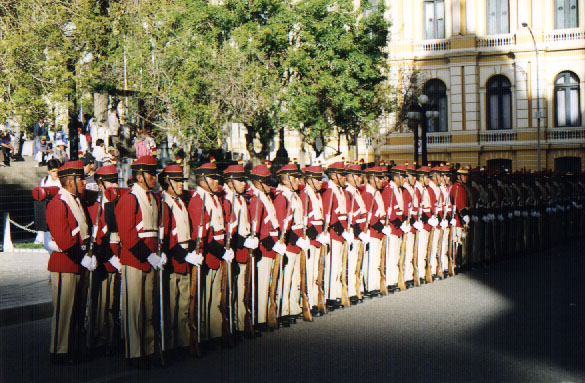 |
| Soldiers standing at attention, Plaza Murillo |
As we approached Murillo I could see several well-armed military policemen redirecting traffic away from the plaza. Beyond them appeared to be rows of soldiers standing at attention. "What's going on?" Susanne and I asked each other. The closer we got we could see the soldiers were wearing Spanish colonial redcoat uniforms, the type that I thought went out of style not long after Bolivar himself gave up the ghost. The redcoats stood in parallel lines, three or four rows deep, apparently waiting for something to happen, someone to arrive. Indeed, I then noticed 20 or so men armed with the big brass implements of a proud military band. Some VIP was bound to show up any minute, we figured, so Susanne and I joined the crowd and watched.
A few moments later a motorcade of five or six bulletproof Mercedes Benzes pulled up in front of the presidential palace. A well dressed man exited the first car and walked to the second - this one marked by Bolivian flags fluttering above the front lights - opening its rear door to allow an older gray-haired gentleman to step out onto the sidewalk. The redcoats' drill sergeant immediately belted out a command, bringing his men to full attention. Was this man President Banzer himself? From this distance I couldn't tell for sure - I wished I had brought my telephoto lens with me. As the first two cars moved forward the third car pulled up, this one bearing the British Union Jack above the headlights. Another chauffeur opened the door, allowing a middle aged, overweight man to step outside.
"Does he look familiar?" I asked Susanne.
"No, not really," she replied. "Definitely not Tony Blair, though."
President Banzer (or not Banzer) stepped forward and shook the VIP's hand. They both turned towards the redcoats, prompting the band to break into the Bolivian national anthem. As soon as the band finished the anthem they took a crack at "God Save the Queen"; unfortunately it sounded as if someone had lost the sheet music and forced them to rely on their impressions of what the anthem should sound like. As the music ended the two men entered the presidential palace, leaving the redcoats lined in front of the plaza. Susanne and I crossed the plaza to reach the far end of the presidential palace, not far from where the VIP's limousine waited. I snapped several pictures of the redcoats as well as the military police, young mestizo men armed with shotguns and tear gas launchers. The weapons seemed unusually large for their slight Quechua build, like young Afghan boys armed with CIA-supplied carbines, waiting patiently for their first chance to kill some Soviets. One MP stood right in front of me, turning his head slowly in search of trouble, his fingers tightening, then relaxing around the pump of his shotgun.
Eventually we realized it was getting closer to our dinner plans, so Susanne and I made a brief stop at the hotel in order to pick up our sweaters. We then began the 30 minute walk to Sopacachi, an upscale neighborhood on the eastern end of the Prado. Sopacachi is well known for its turn-of-the-century villas, many of which were now used as embassies. The Italian restaurant Scott selected for us was hidden somewhere within a nondescript Sopacachi alley, so we would rendezvous at Café Montmartre, a café and bar adjacent to the French embassy and the Alliance Francaise. From the hotel, Susanne and I walked down the steep hill along Calle Bueno, which bottomed out just before the Prado, near the Mercado Camacho. As always in La Paz we had to watch our step, given the steep grade of the street. "Of course, this only means we'll have to walk back up this hill," I grimaced to Susanne.
We soon arrived at the busy intersection of Calle Bueno and Avenida Simon Bolivar. The Camacho market appeared to be winding down for the evening so there wasn't much to see, but for the first time since we drove into the La Paz valley we could see a beautiful view of Inti Illimani, its 21,000-foot snowcapped peak dominating the eastern El Alto skyline. Just before we reached the Prado I noticed a small crowd gathering around the entrance to an office building. A man with large video camera hovered over the gathering, trying to capture whatever was going on at its center. For a moment I could see a man in the middle of the crowd spraying a bottle of chicha on the doorsteps. "I wonder if they're performing a cha'lla ceremony for the opening of a new business," I asked Susanne.
Just beyond the office building Susanne and I reached the Prado, La Paz's bustling Champs Elysees. My first impression of this section of La Paz was, well, this wasn't La Paz - at least not the La Paz we'd experienced so far. This wide, treelined boulevard was jammed with international airline offices, art galleries and Coco Chanel shops. An enormous McDonalds loomed to our left. The Prado seemed as if it had been ripped from the center of Paris of Berlin and dumped in the middle of old Spanish colonial city. We walked east down the Prado, navigating the pedestrian median in the center of the boulevard. There weren't as many people strolling about as I expected, but the restaurants all seemed to be overflowing with people waiting to get inside for an after-work drink. As we passed Plaza del Estudiante we reached the main campus of Universidad Mayor de San Andres. Several hundred students hovered in front of a large hall along the Prado - classes must have just let out. A few blocks later we arrived at Calle Fernando Guachalla, which meant that the Café Montmartre must be somewhere to our right. As soon as we turned the corner we entered another world - quiet, cobblestone streets, gas lamps and Victorian estates.
"Where did this come from?" Susanne said, shaking her head.
"It feels like we dropped off the map and landed in upper Georgetown," I replied.
Two blocks down Fernando Guachalla we found Café Montmartre, an unassuming bar at a peaceful intersection. I could tell up front this would be a good place to unwind. The inside of the café was dimly lit, the walls decorated with Toulouse Lautrec posters and fancifully drawn wall paintings of the Parisian skyline. Susanne ordered a Sprite while I requested a glass of Amstel. A few moments later her soda arrived, but to our chagrin the glass contained several large chunks of ice. "Oh, sin hiero, señor," I said to the waiter. He nodded his head as he grabbed the glass and walked behind the bar. I then watched as the waiter took a spoon and scooped the ice out of the glass, topping it off with a little more soda before returning to our table. "Well, I guess it didn't have that long to melt," Susanne said. "Pass me the Peptos just in case."
As we finished our drinks I noticed it was now 7:15pm - Scott was about 15 minutes late. "No big deal," Susanne commented. "He's been in South America for so long he's picked up the habit of being fashionably late. I'll go stand outside while you polish off your beer." Susanne disappeared around the corner while I relaxed, enjoying the last suds of Amstel to the plaintive reminiscences of Edith Piaf.
By 7:30, I joined her outside, leaning on the cool brick of the café. "How long do we give him?" I asked.
"No rush," Susanne replied. "Let's wait til eight and worry about it then."
A moment or two later Scott appeared, stepping out of a taxi. "Hey guys," he smiled, "let's eat." Ristorante Pronto, it turned out, was just around the corner, hidden down an alley in a basement.
"You're right," I said to Scott, "we probably wouldn't have found this place."
We were the first people inside the restaurant that evening, so it was unusually quiet save the voice of Luciano Pavarotti emanating from speakers in the ceiling. "Everything is good here," Scott said. "I had the lasagna last time." The last lasagna I had was in Cusco two weeks earlier and it had left much to be desired; perhaps ordering it here might restore my faith in the dish. I decided to give it a shot while Susanne selected the Spinach ravioli and Scott ordered the fettucine alfredo. Ever looking for an excuse for a bottle of wine, we requested a Bolivian merlot. Bolivia isn't exactly known for its wines - it's certainly no Chile in that regard - but we figured we should at least give the local vineyards a chance.
The wine soon arrived with toasted garlic bread and breadsticks, which we enjoyed as we talked about our travels. Scott was happy to be going home to California; he was flying to Brazil the next day but would be back on Catalina Island soon after that. "Sopacachi really reminds me of Brazil," he noted. "Lots of towns actually look like this, with the cobblestone and the Old Money estates."
Our waiter returned with our entrees as a group of American women settled around a table not far from us. As I dived into my lasagna (delicious, I should report), I overheard one of the women say, "I really enjoyed living in Washington... Georgetown can really be a great place." Susanne and I looked at each other - once again, it was as if Washingtonians followed us wherever we went, whether it was Bolivia or India or Cambodia. As we polished off the last drops of wine we passed around what was left of our dinners; everyone wanted to try each other's dish. In each case, the ravioli and alfredo were fantastic. I guess Scott was right when he said everything was good here. In the end our bill was 135 bolivianos - less than $30. "If only we could get Italian this good in DC for 30 bucks," I sighed.
Scott had an early morning flight the next day but we decided there was enough time for a drink next store at Café Montmartre. The quiet restaurant had transformed into a crowded bar where chain-smoking thirtysomethings shouted over the din of dance music. "Welcome to Sopacachi nightlife," Scott said. Susanne got a beer while Scott and I each ordered hot chocolate (an instant powder mix improved significantly by a generous dollop of whip cream). It would have been nice to stay for a while and chat, but the claustrophobic cacophony and Scott's impending 5am departure convinced us that we should call it an early evening.
As Scott hailed down a taxi, Susanne and I exchanged addresses with him. "Let me know if you're ever near Catalina," he said.
"And send us an email if you're ever online," I replied.
"Me? Online?," he laughed to himself as he climbed into his cab and closed the door.
Susanne and I hailed our own taxi a moment or two later. "Hostal Republica - cuanto cuesta?" I asked the driver.
"Sies bolivianos," he replied - just over a dollar.
We got into the back seat of the cab and were immediately overwhelmed by the roar of a live soccer match blaring from the car radio. The driver must have seen our expression in the mirror for he lowered the volume - marginally - as he started the drive. I've always been impressed with Spanish soccer announcers - the fastest talkers of a consistently fast language. A man with a deep radio voice screamed out the play-by-play, belting out the names of players like an auctioneer throwing out the latest bids. I managed to catch the words "La Paz" and "Cochabamba," so at least I was able to figure out who was playing. Other than that I was at a complete loss to what was going on until the announcer's voice began to get faster and higher, higher and faster, faster and higher, until
"Goooooaaaaaaalllllll! Goooooooaaaaaaaaaaalllllllllllll!"
An enormous smile overtook my face. "You know," I said, "there's really nothing like taking a cab through the bustling streets of La Paz as the local team kicks some Cochabamba butt.... I really love this town."







